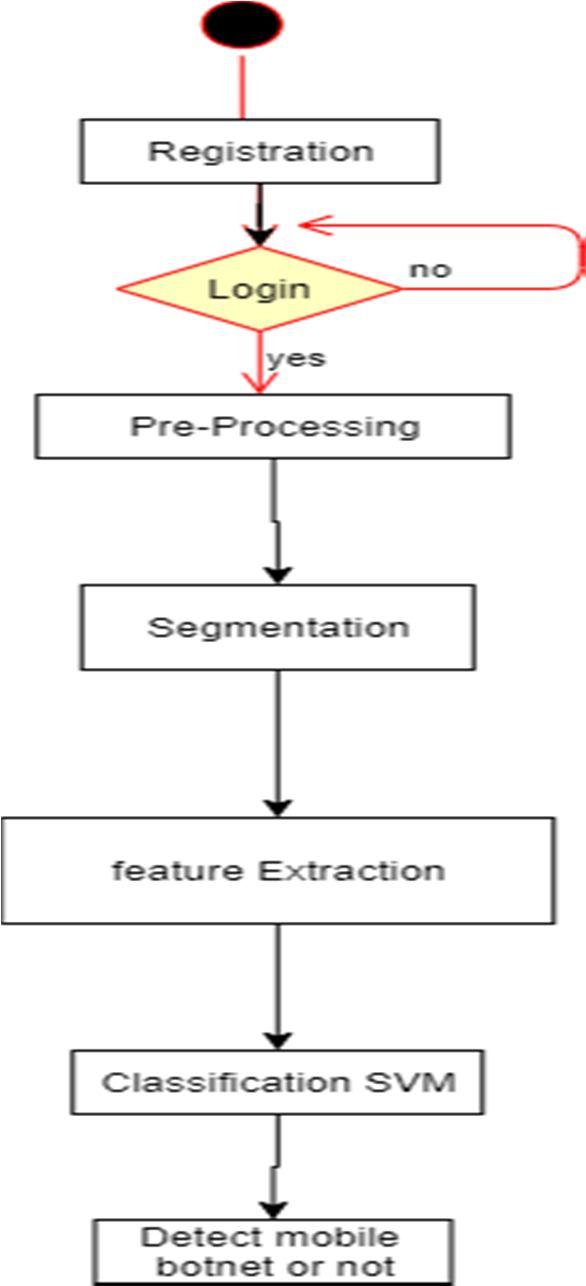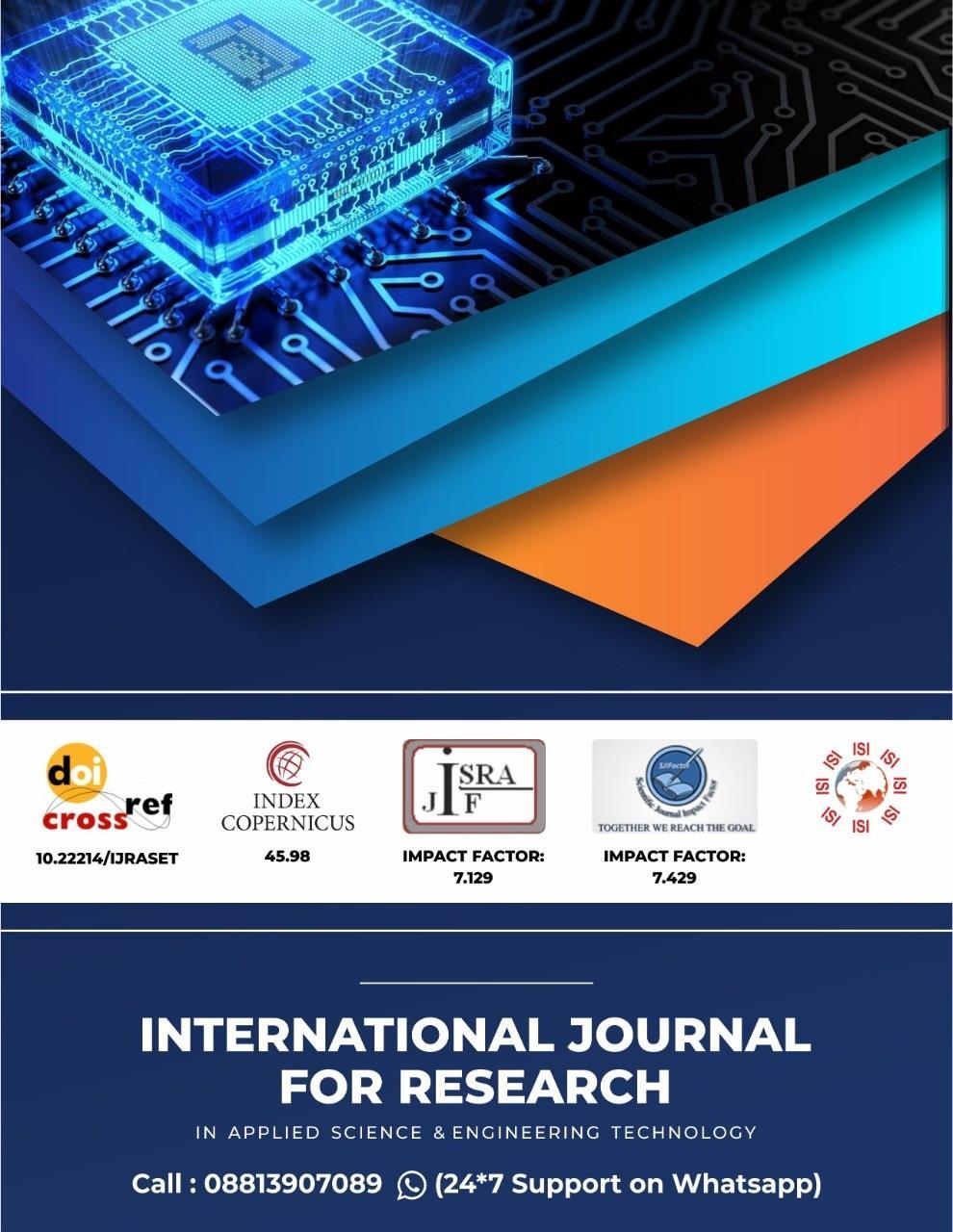https://doi.org/10.22214/ijraset.2023.49506

ISSN: 2321-9653; IC Value: 45.98; SJ Impact Factor: 7.538

Volume 11 Issue III Mar 2023- Available at www.ijraset.com

https://doi.org/10.22214/ijraset.2023.49506

ISSN: 2321-9653; IC Value: 45.98; SJ Impact Factor: 7.538

Volume 11 Issue III Mar 2023- Available at www.ijraset.com
1, 2Student, BECS, DIT, Pimpri
3, 4Student, BEIT, DIT, Pimpri 5Project Guide, DIT, Pimpri
Abstract: Android, being the most widespread mobile operating systems is in- creasingly becoming a target for malware. Malicious apps designed to turn mobile devices into bots that may form part of a larger botnet have become quite common, thus posing a serious threat. This calls -for more effective methods to detect botnets on the Android plat- form. Hence, in this paper, we present a deep learning approach for Android botnet detection based on Support vector machine (SVM). Our proposed botnet detection system is implemented as a svm- based model that is trained on 342 static app features to distinguish between botnet apps and normal apps
Keywords: SVM or Support Vector Machine, SQLite Database, botnet, dataset.
A. Overview
A botnet consists of a number of Internet-connected devices under the control of a malicious user or group of users known as botmaster(s). It also consists of a Command and Control (CC) infrastructure that enables the bots to receive commands, get updates and send status information to the malicious actors. Since smartphones and other mobile devices are typically used to connect to online services and are rarely switched off, they provide a rich source of candidates for operating botnets. Thus, the term ‘mobile botnet’ refers to a group of compromised smartphones and other mobile devices that are remotely controlled by botmasters using CC channels.
B. Project Scope
A botnet is a network of agreed nodes spreading malware software, usually installed by all varieties of attacking methods likes worms, Trojan horses, and viruses. Many techniques have recently been proposed to block mobile malware or detect it.
C. Motivation
They have a strong ability to detect security threats, to collect malware signatures and to understand the motivation and technique behind the threat.
D. Objective
The goal is to set the user up for being unknowingly exposed to a malware infection. You’ll commonly see hackers exploit security issues in software or websites or deliver the malware through emails and other online messages.
E.
In This project We Detect Botnet App. Botnet App Means Some malware are in- stalled in the App through the mobile. That Time loss Your Important Mobile Data. So we Avoid All The loss. Our proposed botnet detection system is implemented as a SVM-based model that is trained on app features to distinguish between botnet apps and normal apps.
A.

SQLite is one of the most popular and easy-to-use relational database systems. It possesses many features over other relational databases. Many big MNCs such as Adobe, use SQLite as the application file format for their Photoshop Lightroom product. SQLite is an embedded, server-less relational database management system. It is an in-memory open-source library with zero configuration and does not require any installation. Also, it is very convenient as it’s less than 500kb in size, which is significantly lesser than other 7410WDSAdatabase management systems.

ISSN: 2321-9653; IC Value: 45.98; SJ Impact Factor: 7.538
Volume 11 Issue III Mar 2023- Available at www.ijraset.com
Anaconda Navigator: Anaconda is an open-source distribution of the Python and R programming languages for data science that aims to simplify package management and deployment. Package versions in Anaconda are managed by the package management system, conda, which analyzes the current environment before executing an installation to avoid disrupting other frameworks and packages. The Anaconda distribution comes with over 250 packages automatically installed. Over 7500 additional open-source packages can be installed from PyPI as well as the conda package and virtual environment manager. It also includes a GUI (graphical user interface), Anaconda Navigator, as a graphical alternative to the command line interface. Anaconda Navigator is included in the Anaconda distribution, and allows users to launch applications and manage anaconda packages, environments and channels without using command-line commands. Navigator can search for packages, install them in an environment, run the packages and update them.
RAM: 8 GB
As we are using Machine Learning Algorithm and Various High Level Libraries Laptop
RAM minimum required is 8 GB. Hard Disk : 500 GB
Data Set of CT Scan images is to be used hence minimum 40 GB Hard Disk memories required.
Processor : Intel i5 Processor IDE : Spyder.
The software development cycle is a combination of different phases such as design- ing, implementing and deploying the project. These different phases of the software development model are described in this section. The SDLC model for the project development can be understood using the following figure the chosen SDLC model is the waterfall model which is easy to follow and fits bests for the implementation of this project.
1) Requirements Analysis: At this stage, the business requirements, definitions of use cases are studied and respective documentations are generated.
2) Design: In this stage, the designs of the data models will be defined and different data preparation and analysis will be carried out.
3) Implementation: The actual development of the model will be carried out in this stage. Based on the data model designs and requirements from previous stages, appropriate algorithms, mathematical models and design patterns will be used to develop the agent’s back-end and front-end components.
4) Testing: The developed model based on the previous stages will be tested in this stage. Various validation tests will be carried out over the trained model.
5) Deployment: After the model is validated for its accuracy scores its ready to be deployed or used in simulated scenarios
6) Maintenance: During the use of the developed solution various inputs/scenarios will been countered by the model which might affect the models overall accuracy. Or with passing time the model might not fit the new business requirements. Thus, the model must be maintained often to keep its desired state of operation.
Let S be the Whole system S= I,P,O I-input
P-procedure
O-output Input( I)
I= Medical Chatbot dataset Where,
Dataset- Text to speech data, Voice to voice, Language Translation Procedure (P), P=I, Using I System perform operations and calculate the prediction
Output(O)-O=System detect chatbot
SVM or Support Vector Machine is a linear model for classification and regression problems. It can solve linear and non-linear problems and work well for many prac- tical problems. The idea of SVM is simple: The algorithm creates a line or a hyper plane which separates the data into classes.


ISSN: 2321-9653; IC Value: 45.98; SJ Impact Factor: 7.538
Volume 11 Issue III Mar 2023- Available at www.ijraset.com
“Support Vector Machine” (SVM) is a supervised machine learning algorithm that can be used for both classification or regression challenges. However, it is mostly used in classification problems.



In Data Flow Diagram,we Show that flow of data in our system in DFD0 we show that base DFD in which rectangle present input as well as output and circle show our system,In DFD1 we show actual input and actual output of system input of our system is text or image and output is rumor detected like wise in DFD 2 we present operation of user as well as admin.
Unified Modeling Language is a standard language for writing software blueprints. The UML may be used to visualize, specify, construct and document the artifacts of a software intensive system. UML is process independent ,although optimally it should be used in process that is use case driven, architecture centric, i terative, and incremental. The Number of UML Diagram is available.




ISSN: 2321-9653; IC Value: 45.98; SJ Impact Factor: 7.538
Volume 11 Issue III Mar 2023- Available at www.ijraset.com



ISSN: 2321-9653; IC Value: 45.98; SJ Impact Factor: 7.538
Volume 11 Issue III Mar 2023- Available at www.ijraset.com
V.

Botnets are a Dangerous evolution in the malware world. They are being used to damage systems, steal information and Comprise Systems. They are hard to detect and eliminate. So Our System Is Useful To detect Mobile Botnet.
[1] S. Y. Yerima and S. Khan “Longitudinal Perfomance Anlaysis of Machine Learning based Android Malware Detectors” 2019 International Conference on Cyber Security and Protection of Digital Services (Cyber Security), IEEE
[2] H. Pieterse and M. S. Olivier, ”Android botnets on the rise: Trends and charac- teristics,” 2012 Information Security for South Africa, Johannesburg, Gauteng, 2012, pp. 1-5.
[3] Letteri, I., Del Rosso, M., Caianiello, P., Cassioli, D., 2018. Performance of botnet detection by neural networks in software-dened networks, in: CEUR WORKSHOP PROCEEDINGS, CEUR-WS.
[4] Kadir, A.F.A., Stakhanova, N., Ghorbani, A.A., 2015. Android botnets: What urls are telling us, in: International Conference on Network and System Security, Springer. pp. 78–91.
[5] ISCX Android botnet dataset. Available from https://www.unb.ca/cic/datasets/android- botnet.html. [Accessed 03/03/2020]

[6] M. Eslahi, M. V. Naseri, H. Hashim, N. M. Tahir, and E. H. M. Saad, ”BYOD: Current State and Security Challenges,” presented at the IEEE Symposium on Computer Applications Industrial Electronics, Peneng, Malaysia, 2014
[7] S. S. C. Silva, R. M. P. Silva, R. C. G. Pinto, and R. M. Salles, ”Botnets: A survey,” Computer Networks, vol. 57, pp. 378-403, 2013.
[8] G. Gu, J. Zhang, and W. Lee, ”BotSniffer: Detecting botnet command and control channels in network traffic,” in Proceedings of the 15th Annual Net- work and Distributed System Security Symposium (NDSS’08), 2008
[9] C. Byungha, C. Sung-Kyo, and C. Kyungsan, ”Detection of Mobile Botnet Using VPN,” in Proceedings of the Seventh International Conference on Innovative Mobile and Internet Services in Ubiquitous Computing (IMIS), 2013, pp. 142-148
